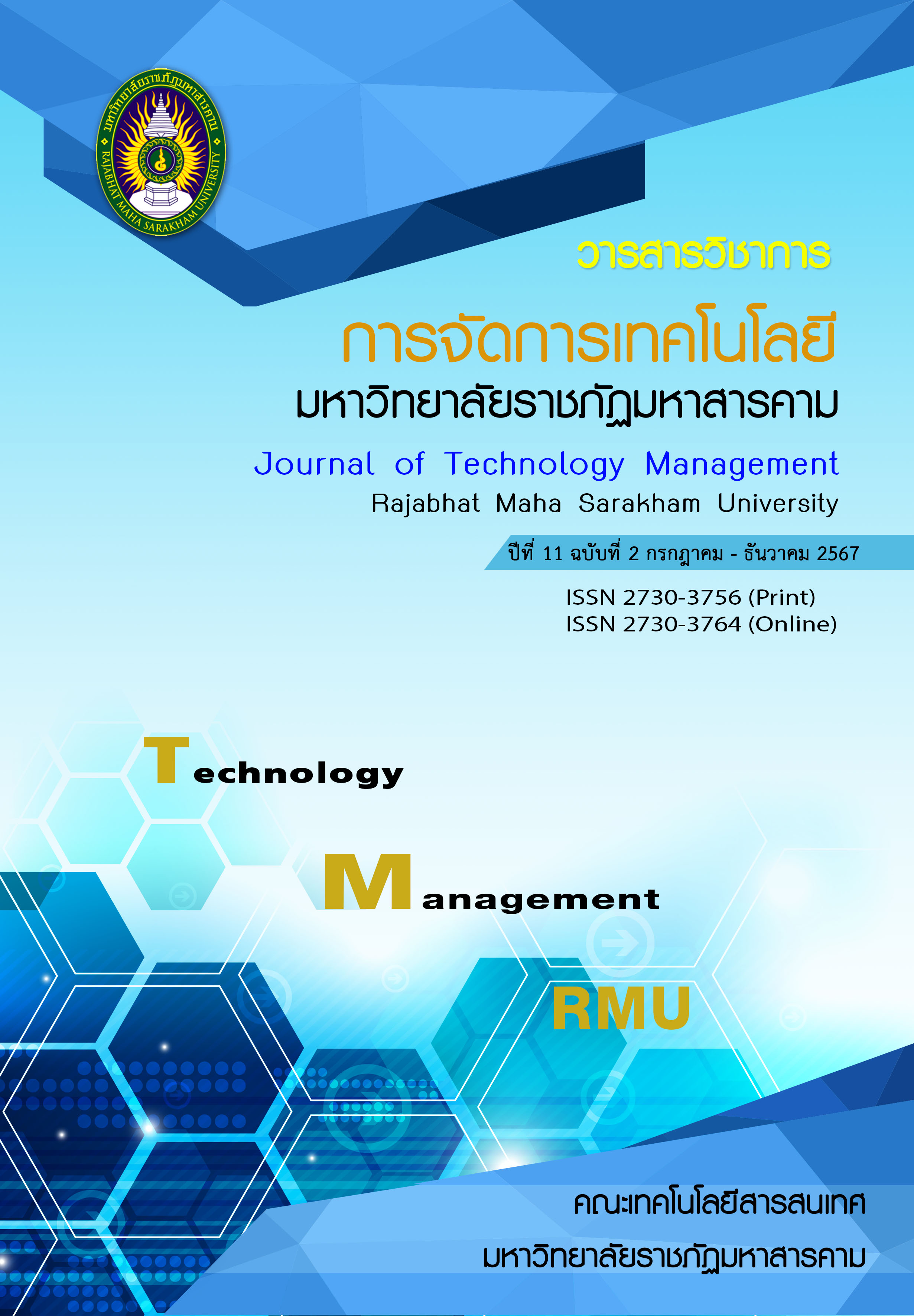Design and Development of a Gamified Mobile Application for Nakhon Pathom Community Ecotourism
Main Article Content
บทคัดย่อ
Gamification and mobile applications have been widely utilized across various sectors to enhance engagement, influence behavior, and improve outcomes. In the tourism industry, gamification and mobile applications have similarly been adopted to advance tourism marketing efforts. This study aimed to develop a gamified mobile application for community ecotourism and evaluate its appearance, functionality, usability, and user satisfaction. A mixed-methods approach was employed in the research. The sample comprised 30 ecotourism entrepreneurs and 400 tourists in Nakhon Pathom, Thailand. Data was collected through non-participant observation, in-depth interviews, and software evaluation questionnaires. Qualitative data were analyzed using triangulation, while quantitative data were analyzed using descriptive statistics. The gamified mobile application was designed by a user interface (UI) designer and developed using a visual programming language with a non-relational cloud database. The application featured three main components, with user roles categorized into two groups: game masters (representing ecotourism entrepreneurs) and players (representing tourists). The game elements included points, badges, leaderboards, and feedback mechanisms. Technologies integrated into the application included QR codes, GPS, Google Maps API, and geo-fencing. The application's core functionality was centered on Google Maps' place markers, with each place marker containing gamified activities. Ecotourism entrepreneurs managed the game content and supported players, while tourists participated in the game by visiting locations, engaging in gamified activities, and providing feedback. The application underwent testing and evaluation by developers and users. The overall user evaluation results indicated high levels of satisfaction, with scores for appearance, functionality, usability, and overall user satisfaction averaging at a high level ( = 4.17, SD = 0.54). The findings suggest that the proposed gamified mobile application represents a viable solution to promote community ecotourism in Nakhon Pathom, effectively meeting the needs and expectations of tourists.
Article Details

อนุญาตภายใต้เงื่อนไข Creative Commons Attribution-NonCommercial-NoDerivatives 4.0 International License.
เอกสารอ้างอิง
Ministry of Tourism and Sports, "International Tourism Statistics Report 2018." Ministry of Tourism and Sports Thailand, Accessed: Oct. 5, 2023. [Online]. Available: https://www.mots.go.th/download/article/article_20190819124714.pdf (in Thai)
R. Buckley, Ecotourism: Principles and Practices. Wallingford, UK: CABI Publishing, 2023.
The International Ecotourism Society, "What Is Ecotourism?." The International Ecotourism Society (TIES). Accessed: Oct. 5, 2023. [Online]. Available: https://ecotourism.org/what-is-ecotourism
Global Ecotourism Network, "Ecotourism: Definition and Key Concepts." Global Ecotourism Network (GEN), Accessed: Oct. 5, 2023. [Online]. Available: https://www.globalecotourismnetwork.org/definition-and-key-concepts
D. Noll, A. Scott, C. Danelutti, et al., "A Guide to Plan and Promote Ecotourism Activities and Measure Their Impacts in Mediterranean Protected Areas Following the MEET Approach," DestiMED Project, Interreg Med Programme, 2019. [Online]. Available: https://www.iucn.org/sites/dev/files/content/documents/a_comprehensive_guide_on_ecotourism_product_development-compressed.pdf
National Statistical Office, "The 2018 Household Survey on the Use of Information and Communication Technology." National Statistical Office Thailand, Accessed: Oct. 5, 2023. [Online]. Available: http://www.nso.go.th/sites/2014en/Pages/Statistical%20Themes/ICT/The-2012-Information-And-Communication-Technology-Survey-In-Household.aspx. (in Thai)
S. Deterding, D. Dixon, R. Khaled, and L. Nacke, "From game design elements to gamefulness: Defining gamification," in Proc. 15th Int. Academic MindTrek Conf.: Envisioning Future Media Environments, 2011, pp. 9–15. https://doi.org/10.1145/2181037.2181040.
K. Werbach and D. Hunter, For the Win: How Game Thinking Can Revolutionize Your Business. Philadelphia: Wharton Digital Press, 2012.
T. Frey, "28 major trends for 2012 and beyond: Part 2," Journal of Environmental Health, vol. 74, no. 9, pp. 39–43, 2012.
K. Huotari and J. Hamari, "Defining gamification: A service marketing perspective," in Proc. 16th Int. Academic MindTrek Conf, 2012, pp. 17–22. https://doi.org/10.1145/2393132.2393137.
A. Harfield, "Exploring mobile gamification of tourism in and around Phitsanulok," An Area-Based Collaboration (ABC) Project. Accessed: Apr. 2015. [Online]. Available: https://s3-ap-southeast-1.amazonaws.com/mobcomlab/uploads/abc-gamification-report.pdf (in Thai)
Y. Chen, "Use of gamification in mobile application to enhance foreign tourists’ cultural experience in China," M.S. thesis, Copenhagen Business School, 2015. [Online]. Available: https://research-api.cbs.dk/ws/portalfiles/portal/58415546/yaxi_chen.pdf.
A. Signoretti, A. Martins, N. Almeida, et al., "Trip 4 All: A gamified app to provide a new way to elderly people to travel," Procedia Computer Science, vol. 67, pp. 301–311, 2015. https://doi.org/10.1016/j.procs.2015.09.274.
Z. Mihaela, R. Simona, I. Andrea, and L. Monica, "Gamification in tourism mobile application development," International Journal of Tourism, vol. 2, pp. 20–23, 2017. [Online]. Available: https://www.iaras.org/iaras/filedownloads/ijt/2017/018-0003(2017).pdf
B. Burke, "Redefine Gamification to Understand Its Opportunities and Limitations," Gartner Research, ID: G00257682, Apr. 3, 2014.
G. Zichermann and C. Cunningham, Gamification by Design: Implementing Game Mechanics in Web and Mobile Apps. Sebastopol, CA: O’Reilly Media, 2011.
J. Kumar, "Gamification at work: Designing engaging business software," In Proc. The Second International Conference on Design, User Experience, and Usability: Health, Learning, Playing, Cultural, and Cross-cultural User Experience, vol. Part II, pp. 528–537, 2013. http://dx.doi.org/10.1007/978-3-642-39241-2_58
C. Buckner, "How to Effectively Use Badges in Your Business," gamification.co. Accessed: Oct. 30, 2014. [Online]. Available: http://www.gamification.co/2014/10/30/how-to-effectively-use-badges-in-your-business
Inc. Bunchball, "Gamification 101: An Introduction to Game Dynamics," bunchball.com. 2016. [Online]. Available: https://www.healthstream.com/docs/default-source/default-document-library/white-paper--bunchball-gamification.pdf?sfvrsn=2
R. Hunicke, M. LeBlanc, and R. Zubek, "MDA: A formal approach to game design and game research," in Proc. The 19th National Conference of Artificial Intelligence: The Challenges in Games AI Workshop, San Jose, CA: AAAI Press, 2004. [Online]. Available: http://www.cs.northwestern.edu/~hunicke/MDA.pdf
S. L. Vargo and R. F. Lusch, "Service-dominant logic: Continuing the evolution," Journal of the Academy of Marketing Science, vol. 36, pp. 1–10, 2008. https://doi.org/10.1007/s11747-007-0069-6.
X. Feifei, B. Dimitrios, and W. Jessika, "Serious games and the gamification of tourism," Journal of Tourism Management, vol. 60, pp. 244–256, 2017. https://doi.org/10.1016/j.tourman.2016.11.020.
M. Sigala, "Applying gamification and assessing its effectiveness in a tourism context: Behavioural and psychological outcomes of the TripAdvisor’s gamification users," Asia Pacific Journal of Information Systems, vol. 25, pp. 179–210, 2015. http://dx.doi.org/10.14329/apjis.2015.25.1.179.


